19 Days in Turkey & Greece
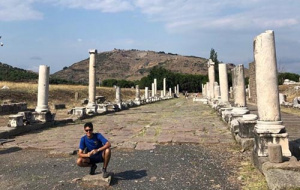 Roger Short Memorial Fund Travel Diary – Josh Sayer
Roger Short Memorial Fund Travel Diary – Josh Sayer
Before I write anything else, I would like to thank Victoria, the Short Family and all the benefactors of the Roger Short Memorial Fund. I would also like to express my gratitude to the staff and students of University College, whose advice and support provided me with valuable advice and insight on travelling in Turkey and creating my itinerary. I feel extremely fortunate to have had the opportunity to travel around Turkey and Greece and I will always have very fond memories of my time there, the sites I visited and the people I met.
I realise that I have written quite a lot, so I thought I would briefly summarise some of my thoughts from my trip and then a day-by-day account follows.
We often look to history for confirmation in times of uncertainty. We only need look at Brexit and its appeal to taking the country back to its “independent” days, or Trump making America great “again”. Sometimes, it can be a source of inspiration and pride. We often also look to the past to see how far we have come and take pride in the progress we have made. No longer are we barbaric enough to watch gladiatorial games, nor foolish enough to use the primitive medical practises they trusted in. However, a little investigation more often than not reveals stories of great strife and struggle, and we frequently see that we share far more with ancient peoples and civilisations than we care to remember, especially in terms of our ambitions, desires and fears.
Why I love ruins is that they are a challenge. These cities were the centres of the greatest prosperity, academia and technological innovation that the world had seen at the time. They were the pinnacle of contemporary society. Yet time and human actions have taken their toll and now, all that remains is rubble in varying states of disrepair. Today, we strive to build the next tallest skyscraper and discover the next breakthrough in our academic fields. Just as then, we consider ourselves to be the pinnacle of contemporary society. When I was visiting various different sites, I was immediately struck by the size, beauty and skill of the cities that had once stood there and an overarching sense of awe was installed in me as well as the majority of visitors, no doubt. We were transported back to the glory days of these cities and we were able to really loose ourselves in the splendour of it all. However, what we often neglect is that we are standing in ruins. As these cities once rose to great power, they also then fell from it. Whether it was due to geographical, political or social factors, the greatest centres of power that the world had ever seen collapsed and came to an end.
I spent a lot of time in Turkey thinking about “power”, especially as I was in the presence Erdogan’s dictatorship and reading a lot about how British politics were unravelling. In short, ruins are a reminder of the temporality and fragility of power, how all things rise and fall. It is a warning, but it is one that can be easily forgotten. Apart from Ephesus and Lindos, my sister and I were part of only a handful of visitors who were at each of these sites. As the sites had once been abandoned, it is a worry that it is happening again, as I heard story after story about how Turkey’s tourism industry has crashed. I fear that the lessons ruins teach may be left behind with these sites, though we are at a time where it feels like we really need them.
However, it was not just the ancient sites that challenged me. The modern cities are a mix of wealth and poverty, urban and natural beauty and all kinds of people. I was fortunate enough to meet and have conversations with several amazing Turkish people, which I talk about individually in the day-by-day account. I also particularly loved Turkish food, but you’ll be glad to know there is a lot less of that in the fuller account! All of these things added up to make an amazing trip that I am incredibly grateful to the trustees and college for enabling. Thank you!
My top “3s” recommendations
Things to bring:
1. A Turkish Sim Card – We would have been lost without it.
2. Chilly’s water bottle – You have to buy bottled water in Turkey and this bottle kept it freezing cold all day, despite the 39 degree heat.
3. Company – My sister, Sophie, was a lovely, patient and fun travel partner and having someone to share my experiences with made my trip.
Places to go:
1. Istanbul
2. Aphrodisias
3. Termessos
Food to eat:
1. Gozleme
2. All meze
3. Pide
Day 1 (12 July)
90 minutes sat on a sticky hot plane stationary on a runway, waiting for storms to clear over mainland Europe, certainly was not the best beginning to our trip, especially since the flight was not due to land at Sabiha Gokcen until 20.45, which, being in the wrong continent, would mean would potentially missing the check-in time for the apartment.
However, the delay gave me time to think ahead over the coming 19 days. I realised that I was more concerned than I expected to be. I had booked very few places / things to do; was not sure if the only place we had booked would be available for us to use; and additionally, was worried somewhat by the current political uncertainty in Turkey, with Erdogan’s losses and the approaching Democracy Day (which I shall speak about more later).
As I was mulling things over, a woman sat next to me, named Elise, introduced herself to me and my sister, Sophie. She was half-Turkish, half-Canadian and gave us lots of recommendations for Istanbul and reminded me of all my excitement to go to Turkey. Hearing our accommodation predicament, she even offered her house for a night. As it would turn out, she was just one of many kind individuals I encountered on this extraordinary trip.
Once the plane got moving, we arrived and were lucky to zip through the airport and jump pretty much straight into a taxi that took us back to Europe and our apartment, near Galata Tower, before the final check-in time. Having climbed up six flights of steep stairs, we settled into our first night.
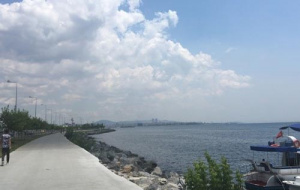 Day 2 (13 July)
Day 2 (13 July)
It seemed Istanbul was filled with attractions and areas that merited a visit / afternoon / day. Since this was supposed to be our only day of sun here, we delayed visiting the major attractions (i.e. the archaeological museum, Hagia Sophia, Blue Mosque etc.) for a rainier day and wanted first to get a feel for this magnificent city. From the apartment, we headed south past Galata tower and across the bridge over the Golden Horn and then just wandered in the general direction of the Grand Bazaar. We put our phones / maps away and went for it.
The natural beauty of Istanbul is incredible, the Bosporus, Golden Horn and Marmara adding glistening borders to the sprawling and hilly city that has gleaming mosques scattered around it as generously as Oxford does hipster coffee shops. It felt bustling and alive, yet not overwhelming busy, which was surprising considering that it was a Saturday, the day on which our guide book has warned us against venturing in the direction of the market. We did not stumble across many empty streets, but then we certainly weren’t overwhelmed by crowds.
The colours and excitement of the Egyptian and Great Bazaars far exceeded my expectations. Teas, spices, sweets, soaps and noise filled my senses. Then, as we continued to wander, we found ourselves looking across the Marmara. I had read that it was possible to get a ferry from somewhere along the coastline back to the Golden Horn and so we headed towards a port we could see in the distance. Unable to find an obvious entrance at first, we met two fellow travellers from Qatar, also lost, but who spoke to us about their adventures in Istanbul and reinvigorated us in the now fully beaming sun. In the end, we opted to walk around the peninsula instead and we were rewarded with the incredible beauty of the bay and a café overlooking the meeting of the Bosporus and Golden Horn at the end of the walk.
Alongside the stunning natural beauty of the city, the other prominent feeling that still resides with me from that day is one of unease. We walked past two young girls sat by a split open bin bag eating the rotting lettuce leaves they had found within it. We also passed a boarded up building that had graffiti sprawled over it, some of which read “Your holiday, our misery”. The poverty in Turkey is unmissable, even in one of the wealthiest areas of its most cosmopolitan city. In my visit to Turkey, I was going to spend a lot of time visiting the ruins of many ancient and formerly great cities. All we see of them is the remains of the great buildings, their coins and the odd tomb with a skeleton within it. What would be remembered of a city like Istanbul? The great mosques and its natural beauty, no doubt; what of the rest of the people who did not live within the 1% of the city? It really challenged how I was going to approach the whole trip.
That evening, I was kindly welcomed to Victoria’s home and her stunning rooftop terrace. We had fascinating conversations about the current state of Turkey, in which I was particularly surprised to learn that Wikipedia has been banned. Erdogan illustrated his power through all kinds of means: the brand new vast mosque on the Asian side of Istanbul; National Democracy Day, a national holiday in remembrance of his crushing of the coupe three years prior; and even website restrictions to limit sources of information reaching the Turkish people. All of these things impacted day to day life, yet in hundreds or thousands of years time, what will we know of it? The remains of the mosque may remain, but what else? The temporary and superficial nature of power struck me, a feeling that would only be strengthened by my visits to the ruined cities that dot the Aegean and Mediterranean coastline.
Day 3 (14 July)
The morning call to prayer accompanied my early rising and morning spent by the toilet, emptying last night’s dinner. My sister was similarly afflicted so we did not leave the apartment (rather gingerly) until 1pm.
Due to the national holiday on the 15th, Istanbul Archaeology Museum was going to be closed so we headed there straightaway. I was somewhat let down by it since a large majority of the museum building and its contents were not available to the public, so we almost spent as long queuing as in the museum itself. Nonetheless, what was on show was particularly interesting to me since there were lots of artefacts, particularly grave stelai, from the Hellenistic and early Roman period, which aligns with Classics modules very well. Most of them were in fact dedicated by women and reflects the prominent public position that (upper class) women were taking in communities throughout the Hellenistic World.
After this, we went to the magnificent Blue Mosque, the interior of which is decorated by 21,000 stunning blue tiles. Unfortunately its central dome blocked from view since it was also undergoing repairs.
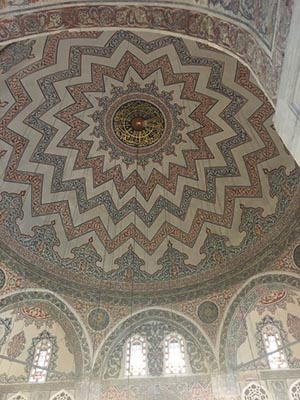 The highlight of the day was an unplanned visit to the tomb of Sultan Ahmet I (pictured), the great patron of the Blue Mosque. Situated very close to the Blue Mosque, its interior is similarly decorated with stunning blue Iznik tiles. It wasn’t busy and was a quiet space amidst the bustling Sultanahmet. It was interesting to compare these death rituals from those I had seen in the archaeology museum. It was still all about power display and was centred round all the family being in one place, or at least being depicted as such. All that had really changed was the scale, now having an entire building in the centre of the city instead of a shared space outdoor space in a necropolis, usually located on the perimeter of the city. Whatever was considered the peak of technological and artistic development can generally always be traced in funerary art. Death was (is) the one of the most important areas for displaying power and success, something that seems incredibly paradoxical to me.
The highlight of the day was an unplanned visit to the tomb of Sultan Ahmet I (pictured), the great patron of the Blue Mosque. Situated very close to the Blue Mosque, its interior is similarly decorated with stunning blue Iznik tiles. It wasn’t busy and was a quiet space amidst the bustling Sultanahmet. It was interesting to compare these death rituals from those I had seen in the archaeology museum. It was still all about power display and was centred round all the family being in one place, or at least being depicted as such. All that had really changed was the scale, now having an entire building in the centre of the city instead of a shared space outdoor space in a necropolis, usually located on the perimeter of the city. Whatever was considered the peak of technological and artistic development can generally always be traced in funerary art. Death was (is) the one of the most important areas for displaying power and success, something that seems incredibly paradoxical to me.
Lastly, we visited the hippodrome since I wanted to see the remains of the Serpent Column, moved by Constantine to Istanbul from Delphi. It was originally built to commemorate the Greeks who had repelled the Persians in 479BC and had the names of the Greek tribes inscribed into the coils of the three snakes that make up the column. Today, it only stands at half height and is severely weather damaged – a final reminder for the day of the transience of power.
Day 4 (15 July)
For lunch, we met Sophie’s friend, Arabella, who had lived in Istanbul for 4 years. Over the first food we had had for over 24 hours, we discussed the travel plan we had. I remember our discussion about Ephesus where she told us that we would find tourists clambering all over the ruins. Our natural, English response to this is horror but it got me thinking about how we interact with ancient monuments. I 100% agree with preserving ancient sites but I think especially in England, maintenance of certain historical objects is linked to our desire to preserve our powerful status as a nation, which is inextricably linked to our past. Similarly motivated is our inability to return ancient objects back to the countries they belong to. Not to say that I think the swathes of tourists at Ephesus are performing some kind of radical protest, but thinking about it certainly challenged some of my basic presumptions.
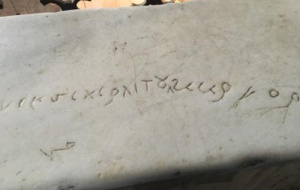 Today was National Democracy Day and its third anniversary was also the first time Erdogan’s holiday had fallen after he had lost his mayors in the three largest cities in the country, Istanbul, Ankara and Izmir. Somewhat apprehensive therefore, we queued for the Hagia Sophia. It was vast and beautifully decorated, especially the renaissance mosaics on the balcony level. I really enjoyed a less majestic element, namely the graffiti of a bored Viking guard on one of the balconies (pictured). I found it funny how something scribbled with probably very little thought behind it had lasted longer and was of more fame than many of the now lost Byzantine masterpieces of art that it stood by. This was also the first time on the trip that I had a real sense of standing where people of antiquity had stood which was very exciting.
Today was National Democracy Day and its third anniversary was also the first time Erdogan’s holiday had fallen after he had lost his mayors in the three largest cities in the country, Istanbul, Ankara and Izmir. Somewhat apprehensive therefore, we queued for the Hagia Sophia. It was vast and beautifully decorated, especially the renaissance mosaics on the balcony level. I really enjoyed a less majestic element, namely the graffiti of a bored Viking guard on one of the balconies (pictured). I found it funny how something scribbled with probably very little thought behind it had lasted longer and was of more fame than many of the now lost Byzantine masterpieces of art that it stood by. This was also the first time on the trip that I had a real sense of standing where people of antiquity had stood which was very exciting.
We exited the Hagia Sophia to be greeted by a large number of TV crew vans outside. A crowd was also growing which we decided to join. We were then presented with an interpretive dance that involved countless Turkish flags. After it had (quickly) finished, we seemed to be as surprised as the rest of the crowd as the dancers packed away as did the TV crews. It was the only event we had seen put on for Erdogan’s day.
Lastly, we visited the Theodosius Cistern, which are far less busy than the Basilica Cistern (no queue!), and also is free! Although it is smaller, it did have some water in it too, unlike the Basilica Cistern at the time. It was only uncovered in 2010 when an old town hall was knocked down. Its scale was still very impressive and it is difficult not to marvel at the architectural genius of such a space / how odd it is they decorated an underground water chamber that no one visited with beautiful Corinthian columns.
Day 5 (16 July)
We took the overnight bus from Istanbul to Izmir and arrived at 7am after a few hours of sleep. Our tiredness, inability to navigate the not-so-tourist-friendly otogar and lack of a place to stay in Izmir made the morning quite stressful but after two hours, we located the free shuttle bus into the town centre and found our hotel. (You certainly don’t need to book everything in advance of your trip, but I would definitely recommend booking somewhere before you arrive at the city or earlier, especially if your Turkish isn’t up to scratch.)
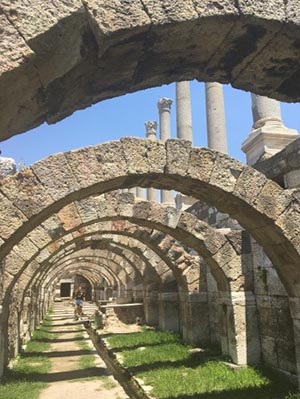 Eager to find food, we walked towards the sea and were greeted by an extraordinarily beautiful bay surrounded by mountains. Neither of us were feeling quite 100% still after the food positioning and didn’t fancy returning to the otogar just yet so we decided to visit the ruins of ancient Smyrna in the city centre of Izmir. Izmir now occupies most this important ancient city, which was founded by Alexander the Great. Strabo wrote that Alexander came to Mount Pagos (which we climbed up after visiting the ruins) and fell asleep under a plane tree by a spring in front of a Temple of Nemesis. He saw the goddess in a dream, who told him to move the people of Smyrna to a new site, where the ruins and Izmir now are. The site was a great one to start with – it had lots of information points around the not too large site, which was dominated by the large agora. It was typical of the Hellenistic city style I have been studying this year and was also interesting due to later developments in the city, such as a Roman villa that had built blocking the way to the bouleuterion (council house) and the large array of Ottoman cemetery stones since this area had been turned into an Ottoman cemetery.
Eager to find food, we walked towards the sea and were greeted by an extraordinarily beautiful bay surrounded by mountains. Neither of us were feeling quite 100% still after the food positioning and didn’t fancy returning to the otogar just yet so we decided to visit the ruins of ancient Smyrna in the city centre of Izmir. Izmir now occupies most this important ancient city, which was founded by Alexander the Great. Strabo wrote that Alexander came to Mount Pagos (which we climbed up after visiting the ruins) and fell asleep under a plane tree by a spring in front of a Temple of Nemesis. He saw the goddess in a dream, who told him to move the people of Smyrna to a new site, where the ruins and Izmir now are. The site was a great one to start with – it had lots of information points around the not too large site, which was dominated by the large agora. It was typical of the Hellenistic city style I have been studying this year and was also interesting due to later developments in the city, such as a Roman villa that had built blocking the way to the bouleuterion (council house) and the large array of Ottoman cemetery stones since this area had been turned into an Ottoman cemetery.
Day 6 (17 July)
An early wake-up, two dolmuses and a few hours travel took us to Bergama, the modern town home to Pergamum, one the sites I was most excited to visit! It was the capital of the Pergamene kingdom, which reigned from the 3rd-1st centuries BC and was a key player in the rise of Rome and a keen patron of the arts, evidenced by the magnificent sculptures and library found there.
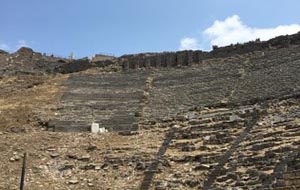 Although the most striking part of the acropolis, reached by cable car, were Emperor Trajan’s additions, I spent most of my time at the damaged foundations of the Altar of Zeus (now in Berlin in its entirety) and the remains of the sanctuary of Athena Nikephoros, two buildings I have studied about a lot. The theatre was also breath-taking, situated in the hill looking across the plains below for miles. As I leapt around the ancient city, I recounted as much I could remember about everything I was seeing to Sophie which only got me more and more hyped up about the site. All the abstract facts and vague memories of photos I had seen and learned were right in front of me.
Although the most striking part of the acropolis, reached by cable car, were Emperor Trajan’s additions, I spent most of my time at the damaged foundations of the Altar of Zeus (now in Berlin in its entirety) and the remains of the sanctuary of Athena Nikephoros, two buildings I have studied about a lot. The theatre was also breath-taking, situated in the hill looking across the plains below for miles. As I leapt around the ancient city, I recounted as much I could remember about everything I was seeing to Sophie which only got me more and more hyped up about the site. All the abstract facts and vague memories of photos I had seen and learned were right in front of me.
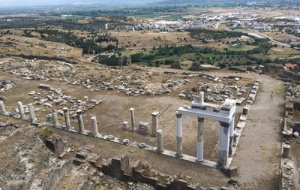 We walked down the hill which drove home how incredible the construction of such a site was. That hill was BIG and very steep at points, even as we followed the ancient road. Transporting vast amounts of stone wasn’t the only problem the Pergamene kings faced, since there was also no nearby water supply, so they constructed over a pipeline that relied on gravity alone to transport it 40km from the Madradag Mountains. Experiencing the midday scorching heat and harsh nature of the rocky, mountainous terrain only puts into perspective how extraordinary / mad these feats were, all so that the kings could have their palace on the same, highest level of terrain as the ancient temples that predated them in this area. Thirst to display power here then lead to incredible ingenuity. Also, walking down meant we walked through the rest of this large city, passing both the gymnasia, houses, more temples that citizens would have used daily, and the lower agora. The city was organised hierarchically i.e. the higher you were, the richer you were, so was an actual incarnation of the property ladder. Walking down highlighted how stark the separation would have been, but it also struck me that is not too dissimilar to how some people hunt for houses based on their postcode alone nowadays and wouldn’t dream of living anywhere else. We tend to distance ourselves from people of the past especially when we visit the stone ruins they lived in, but often the ideologies that defined them really have not changed much.
We walked down the hill which drove home how incredible the construction of such a site was. That hill was BIG and very steep at points, even as we followed the ancient road. Transporting vast amounts of stone wasn’t the only problem the Pergamene kings faced, since there was also no nearby water supply, so they constructed over a pipeline that relied on gravity alone to transport it 40km from the Madradag Mountains. Experiencing the midday scorching heat and harsh nature of the rocky, mountainous terrain only puts into perspective how extraordinary / mad these feats were, all so that the kings could have their palace on the same, highest level of terrain as the ancient temples that predated them in this area. Thirst to display power here then lead to incredible ingenuity. Also, walking down meant we walked through the rest of this large city, passing both the gymnasia, houses, more temples that citizens would have used daily, and the lower agora. The city was organised hierarchically i.e. the higher you were, the richer you were, so was an actual incarnation of the property ladder. Walking down highlighted how stark the separation would have been, but it also struck me that is not too dissimilar to how some people hunt for houses based on their postcode alone nowadays and wouldn’t dream of living anywhere else. We tend to distance ourselves from people of the past especially when we visit the stone ruins they lived in, but often the ideologies that defined them really have not changed much.
At the entrance to the site of Pergamum, we had decided to purchase 7-day Aegean passes, which granted us access to all the ancient sites / museums along the Aegean coast. I would highly recommend buying one if you are travelling around the area since the price of individual tickets builds up quickly and it is shame for that to put you off visiting as many of the brilliant sites as you can. We ended up saving a lot of money by purchasing the pass.
Taking advantage of the card straightaway, we visited the Red Basilica in Bergama, the vast ruins of Roman church that had once housed an Egyptian cult inside it and was one of the most important churches in Asia Minor, cited in the bible a few times. Afterwards, we went to Bergama’s Archaeology Museum, which I recommend highly. It was small but filled with a range of interesting artefacts from Pergamum, Red Basilica and Asklepion. Particularly excellent were the coins that the Pergamene kings had minted since their kingdom formed an economical league rather than purely a royal hegemony. This was the period when kings first were having their portraits minted on coins but the Pergamene kings seemed to have more inclusive approach with local, pre-existing communities.
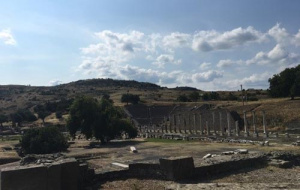 The Asklepion, on the other side of Bergama to the acropolis, was our final site of the day and it was a gem. First you walk through the remains of the Via Tecta (Covered Walkway) that extended all the way to acropolis and was lined by sculptures and busts the whole way (now in the museum). This Asklepion was one of the most important healing cults in antiquity and in the afternoon sun, quiet calm of the site, gentle bubbling of the natural springs and the beautiful buildings framing the natural landscape, it is easy to understand how people would have recovered there.
The Asklepion, on the other side of Bergama to the acropolis, was our final site of the day and it was a gem. First you walk through the remains of the Via Tecta (Covered Walkway) that extended all the way to acropolis and was lined by sculptures and busts the whole way (now in the museum). This Asklepion was one of the most important healing cults in antiquity and in the afternoon sun, quiet calm of the site, gentle bubbling of the natural springs and the beautiful buildings framing the natural landscape, it is easy to understand how people would have recovered there.
Day 7 (18 July)
Most of the day was spent navigating dolmuses and coaches to get to Pamukkale via Denizli. The drive took us through stunning countryside, mountains omnipresent in the new distance and fertile plains on the flats between them. It was the perfect setting to be reading Virgil’s Georgics, a Latin poem about the pleasures and troubles of farming in beautiful, fertile countryside. Then, in the distance, amongst the sandy hazy mountains, we could see a white mass.
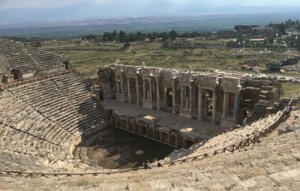 This was of course the travertines, a site so bizarre that a whole ancient city, Hierapolis, was constructed in the hills above it. The jewel of the city was the 3rd century AD theatre which had had lots of time spent on it to restore its former scale and glory. It alone made the visit worthwhile. The large site also had an extensive necropolis that was interesting to explore with its variety of tombs from various time periods (and large variety of lizards as the only company). Then we left the site via the amazing travertines. At the top, it was very busy and somewhat unappealing since lots of the salt had gone from constant wear so it was just like walking bare foot on water stone. However, once you had made it past them, it was a lot calmer (since many have to return to the top car park as part of tour groups). We settled into one the pools and enjoyed watching a beautiful sunset.
This was of course the travertines, a site so bizarre that a whole ancient city, Hierapolis, was constructed in the hills above it. The jewel of the city was the 3rd century AD theatre which had had lots of time spent on it to restore its former scale and glory. It alone made the visit worthwhile. The large site also had an extensive necropolis that was interesting to explore with its variety of tombs from various time periods (and large variety of lizards as the only company). Then we left the site via the amazing travertines. At the top, it was very busy and somewhat unappealing since lots of the salt had gone from constant wear so it was just like walking bare foot on water stone. However, once you had made it past them, it was a lot calmer (since many have to return to the top car park as part of tour groups). We settled into one the pools and enjoyed watching a beautiful sunset.
Day 8 (19 July)
Neatly, our eight day was our “day of 8 dolmuses”. Our aim was to get to Aphrodisias, as previous Roger Short traveller Flo had strongly recommended to me. Unfortunately, the advertised tours there from our hotel had stopped running a few years ago due to lack of tourist demand. The hotel manager kindly offered a round trip taxi from his friend for 450 TL, so we opted for the longer but far cheaper route of public transport. It took us four hours and four dolmuses each way but we were rewarded by it being 60 TL in total for the two of us and also by the kindness of Turkish people who helped us navigate our way there through different cities, cities and villages.
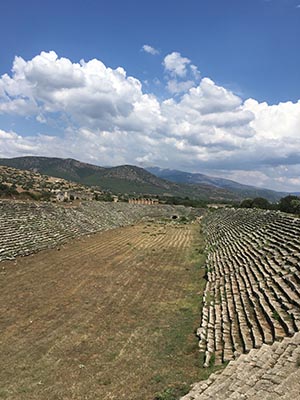 Aphrodisias was the most favoured city of Augustus in Asia Minor and the Oxford led digs and restorations there pay testament to that. The stadium is one of the largest and most intact stadiums we know of and is great fun to walk around. There is so much to explore and we spent the whole day there. There is also a brilliant museum containing many of the artefacts found there, including the brilliant life size frieze from the Sebasteion depicting a series of myths pertaining to the founding of Rome and also the first emperors of Rome.
Aphrodisias was the most favoured city of Augustus in Asia Minor and the Oxford led digs and restorations there pay testament to that. The stadium is one of the largest and most intact stadiums we know of and is great fun to walk around. There is so much to explore and we spent the whole day there. There is also a brilliant museum containing many of the artefacts found there, including the brilliant life size frieze from the Sebasteion depicting a series of myths pertaining to the founding of Rome and also the first emperors of Rome.
There was also a great little exhibition of photographs taken when archaeologists first arrived in the rural village by the adjacent ancient site. It documents how villagers were using the ancient tombs as grape presses and donkeys grazed in the agora amongst fallen pillars. It really challenged my foregone perceptions of how / why we value things and also how all rises and falls. Local villagers had seen the ruins as, at best, things that could be useful, at worse, a hindrance. To start the dig, they lost a lot of arable farmland, something necessary for their living, something that is still evident with abundant fields neighbouring the stadium. Now tourism is not even bringing in much revenue for the local community either since it is so out of the way. The clash between prosperity and utility was quite striking.
Day 9 (20 July)
Before checking out of the hotel, I wanted to visit Laodoceia, another ancient site only 9km away from Pamukkale. It was a Seleucid settlement named after the the Seleucid queen. You enter via the site via a hill with a few underwhelming rocks dotted around it. However, once over the crest of the hill, you could see that this was another excellent and extensive site. There were two theatres, the northern one looking over to the travertines. There is so much to explore but it was very easy to get lost with lots of dead ends due to the ongoing digging. It was very interesting to see the ongoing however, in particular how far down they have had to dig to uncover these ruins. There was also an early Christian church there with beautiful mosaics surviving inside. It is an important site of pilgrimage for Christians as I discovered thanks to a large group of American, Christian tourists who were the only other morning visitors.
I quickly had to dash back to the hotel and felt very Turkish waving down a dolmus from the side of the motorway. Then we headed off to Selcuk via another three buses. After four and a half hours, we arrived at the nicest accommodation we would stay at all trip. Anyone who visits Selcuk, check out “Atilla’s Getaway”: though it is slightly outside Selcuk itself, this family run hotel runs free ferry services and you are then rewarded with swimming pools, stunning views, breezes so pleasant it made the 38 degree heat bearable and the kindest, most welcoming hosts. And this was one of the cheaper places that we stayed in.
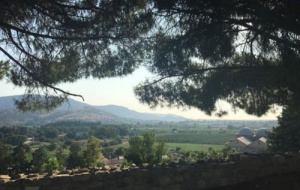 After we had arrived in the late afternoon, they kindly gave me a lift into the centre of town so I could visit the Ephesus Museum, yet another site included on our Aegean Passes. Going to the museum before going to Ephesus itself inadvertently was very helpful since it meant that my visit to the second most popular tourist attraction in Turkey, second only to the entire district of Sultanahmet, really came to life. After this, I went up Ayasuluk Hill to visit St John’s Basilica, which is believed to the burial site of St John. Although my late arrival meant that the adjacent castle was closed, instead I had the added bonus of the site being particularly empty, quiet and suitably meditative for my second Christian pilgrimage site of the day.
After we had arrived in the late afternoon, they kindly gave me a lift into the centre of town so I could visit the Ephesus Museum, yet another site included on our Aegean Passes. Going to the museum before going to Ephesus itself inadvertently was very helpful since it meant that my visit to the second most popular tourist attraction in Turkey, second only to the entire district of Sultanahmet, really came to life. After this, I went up Ayasuluk Hill to visit St John’s Basilica, which is believed to the burial site of St John. Although my late arrival meant that the adjacent castle was closed, instead I had the added bonus of the site being particularly empty, quiet and suitably meditative for my second Christian pilgrimage site of the day.
Day 10 (21 July)
We woke up early in order to try and beat the fabled queues and busyness of Ephesus. We were too early for the free hotel service so caught a dolmus from the side of the motorway to take us into the centre and then caught another to Ephesus. Thought I thought Ephesus was very close to the centre, it took the sight of water parks in the distance to finally make us realise that we had missed the point where we were supposed to call to the driver to stop and now were headed to Kusadasi. Having read Theodore’s scathing review of the place from his travels last year and still hoping to beat the crowds, we got off the bus before it had got near to the centre and once more had to flag down a dolmus to take us back. We still managed to arrive at 8.45am, when, to our surprise, we practically had the place to ourselves. Having been spoilt by the stunning array of sites that I had visited where we would see many more dogs /lizards than other tourists, I was actually slightly disappointed that there was no one here too. I was in fact quite looking forward to experiencing a site in a way that would have been more like the ancient city itself i.e. packed with people from all across the world. Indeed, Ephesus was the capital of the Roman province of Asia.
In the end, we ended up having the best of both worlds. There are two entrances into the site: one from the north which means you only need to walk down the hilly site; and one from the south, which is easily accessible by public transport but means you need to walk up and then turn back on yourself and come down the same way. We were fortunate to have the site calm and clear so we could enjoy the site and read all the signs without dodging photographs the whole way up the hill. Then, by the time we had reached the top and were turning back, the people were pouring into the site. The city was no longer just ancient ruins, but had something of its city life restored as well.
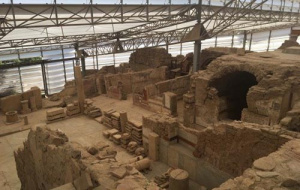 The site itself is beautiful and the restorations are not overdone but truly magnificent. The library never fails to impress, but the highlight for me was the terraced houses (which would have been an additional fee, had it not been for our passes!). It is rare to see such well-preserved housing with stucco walls, mosaics and columned courtyards intact. Being central in the city, these were the houses of the elite and the vast size of the waiting halls for some of these houses attests to that.
The site itself is beautiful and the restorations are not overdone but truly magnificent. The library never fails to impress, but the highlight for me was the terraced houses (which would have been an additional fee, had it not been for our passes!). It is rare to see such well-preserved housing with stucco walls, mosaics and columned courtyards intact. Being central in the city, these were the houses of the elite and the vast size of the waiting halls for some of these houses attests to that.
Afterwards, we decided to walk back into Selcuk. Following the one way road out of the site, you pass by more ruins, including some baths and the retaining walls for the stadium! Then we walked back into Selcuk (it’s less than a 2km walk) along a very pleasant avenue adjacent to the main road. This took us to the Artemision, one of the 7 Wonders of the Ancient World. Though there is now very little to see i.e. one column with storks nesting atop it and a few foundation walls, it was still fun to see. As we walked onwards into Selcuk, I realised that the Artemision was in line with St John’s Basilica ahead and Ephesus behind and that we were probably walking along an old pilgrimage route.
The rest of the afternoon was spent in Selcuk talking to dolmus drivers and trying to haggle with taxi drivers. I wanted to find a way to visit Priene, Miletus and Didyma in an affordable way, and although I managed to haggle down a taxi from 600 TL to 350 TL, it was still pretty expensive since my sister wasn’t going to come with me that day. We also needed to go back into Aydin so that we could book an early coach in order to try and make a 9.15am ferry ride to Marmaris in a couple of mornings time, a journey that took around 3 hours. We had looked at places to stay in Marmaris but they were all very expensive and very far away from the ferry terminal so we were keen to find an alternative.
Day 11 (22 July)
The alternative we reached was getting a 6am coach from Aydin (the closest main bus station to Selcuk, about an hour drive away) that would arrive at Marmaris slightly after 8am, a short distance away from the ferry. We wanted to be sure that we had seats on that 6am otherwise we would miss the ferry, which wasn’t really an option we wanted to think about. Therefore we went to Aydin bus station to book them since it isn’t possible to book buses online unless you have a Turkish identity number.
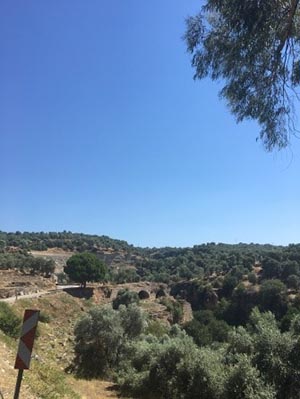 Relatively close to Aydin was an ancient site called Nysa, fabled to be the place where Dionysus was brought and also the home of famous 1st century BC geographer Strabo. We were dropped off in the sleepy town of Sultanhisar by the dolmus and it was a 3km uphill walk from the centre. This was least touristy site we visited by some way i.e. we saw no one else there except archaeologists. It was so empty and low key that we didn’t even realise the pay point at the entrance.
Relatively close to Aydin was an ancient site called Nysa, fabled to be the place where Dionysus was brought and also the home of famous 1st century BC geographer Strabo. We were dropped off in the sleepy town of Sultanhisar by the dolmus and it was a 3km uphill walk from the centre. This was least touristy site we visited by some way i.e. we saw no one else there except archaeologists. It was so empty and low key that we didn’t even realise the pay point at the entrance.
Nysa is set in an incredibly dramatic manner on either side of a ravine, through which the river Meander used to run. They are currently uncovering a Roman stadium that straddled the ravine and there is also a spooky yet extraordinary tunnel that runs under the site through the ravine which is definitely worth walking through. Upon arrival we were instantly drawn to the large theatre with a capacity of 12,000, which overlooked the ravine. There are also the remains of second largest library, after Ephesus, in Asia Minor. The rest of the site is still very much being uncovered, and though they reckon that the city followed a grid-like plan, we were guided more by the aligned olive trees than anything else.
A dolmus took us back to Aydin and the Archaeological Museum there. This was my favourite museum of them all. It housed finds from all sites around the ancient Carian region and large amounts of information about each of the sites in the region, including Nysa. The highlight of the museum was definitely the frieze that used to adorn the scena of the Nysan theatre, depicting Dionysus’ birth and upbringing in the Nysan Mountains.
That evening, we had dinner with Atilla, the hotel owner, who told us about how the past 5 years had tourism be decimated. We were 2 of the 12 people staying there, whilst this hostel used to be packed to its 70 people limit for all 3 summer months. However, he was optimistic that tides were turning – after all, everything ebbs and flows, rises and falls, something the ancient ruins remind you constantly.
Day 12 (23 July)
How naïve I was to think that 8 dolmuses would be the most public transport I would use in a day. Instead of taking a taxi to get to Priene, Miletus and Didyma (the preferred, but expensive, option / the only viable option as it would turn out), I decided to try my luck with public transport and a vague idea of how to get to each place. My vagueness encouraged my sister to spend the day by the pool instead. This also meant that I would have no internet data, we had only bought a sim card for my sister’s phone.
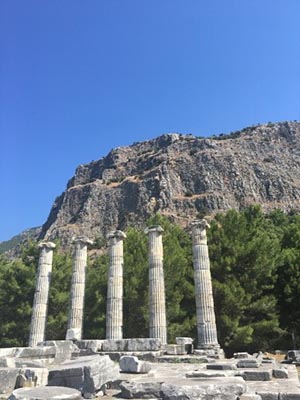 I managed to reach Priene fairly painlessly and quickly, situated on Mt Mycale. I took the dolmus into Selcuk, then to Kusasadi, then to Soke and finally to Gullabache, a village located at the bottom of Mt Mycale. Along with Pergamum, this was the site I was most excited to visit, having studied this site just as much. The ruins are practically all Hellenistic, having not been inhabited by Romans or later peoples, so it really gives you a sense of the new type of city that Alexander and the Hellenistic kings were popping up all across their vast empires. Therefore, I was keen to cover every inch of the site, and having arrived early, I had it to myself. Having entered from the west gate, I went all the way to the east gate, a straight path that dissects the city and along most of the important civic buildings are positioned, including the agora, theatre, bouleuterion, prytaneion and the temple of Athena Nikephoros. At the very north of the site is the temple of Demeter (though tricky to reach, the views are definitely worth the climb) and the south holds the gymnasium. Priene used to be a trading city by the sea, but there was an excellent map showing how the water levels had decreased over the years and had now completely silted up. Indeed, Ephesus and Miletus were also trading hubs due to their ports; however, the fertility of the plains where the sea used to be mean it is not too hard to imagine.
I managed to reach Priene fairly painlessly and quickly, situated on Mt Mycale. I took the dolmus into Selcuk, then to Kusasadi, then to Soke and finally to Gullabache, a village located at the bottom of Mt Mycale. Along with Pergamum, this was the site I was most excited to visit, having studied this site just as much. The ruins are practically all Hellenistic, having not been inhabited by Romans or later peoples, so it really gives you a sense of the new type of city that Alexander and the Hellenistic kings were popping up all across their vast empires. Therefore, I was keen to cover every inch of the site, and having arrived early, I had it to myself. Having entered from the west gate, I went all the way to the east gate, a straight path that dissects the city and along most of the important civic buildings are positioned, including the agora, theatre, bouleuterion, prytaneion and the temple of Athena Nikephoros. At the very north of the site is the temple of Demeter (though tricky to reach, the views are definitely worth the climb) and the south holds the gymnasium. Priene used to be a trading city by the sea, but there was an excellent map showing how the water levels had decreased over the years and had now completely silted up. Indeed, Ephesus and Miletus were also trading hubs due to their ports; however, the fertility of the plains where the sea used to be mean it is not too hard to imagine.
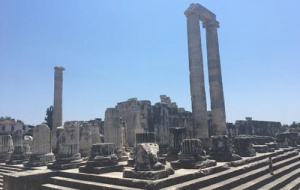 I was instructed to return to Soke in order to find transport to Miletus, but whenever I mentioned the place to someone at the bus stop or or dolmus drivers, it looked like I had just asked them the whereabouts of Atlantis. One man suggested I take the bus to Didim and hop off at the right point; this was then confirmed by another man, named Oscar, who sat next to me as I was waiting for the dolmus. It turned out he was from Didim and having ascertained I was English, he told me that he had lived in Australia for 20 years and we spent the whole journey talking. He also revealed why getting to Miletus was a problem – this was the best dolmus to take, but the closest it got to Miletus was 9km, the rest of which you had to walk. He instead encouraged me to go to Didim with him and promised to take to the Temple of Apollo there and having seen lots of cities, I was pretty keen to get to this temple which impressed everyone who went. It was a long, packed and hot journey to Didim and when we got off, the stop was right next to his house. He welcomed me in and gave me some figs fresh from his tree outside. Then we walked over to the temple, a short walk, that quickly revealed why the temple impressed everyone who got to see it.
I was instructed to return to Soke in order to find transport to Miletus, but whenever I mentioned the place to someone at the bus stop or or dolmus drivers, it looked like I had just asked them the whereabouts of Atlantis. One man suggested I take the bus to Didim and hop off at the right point; this was then confirmed by another man, named Oscar, who sat next to me as I was waiting for the dolmus. It turned out he was from Didim and having ascertained I was English, he told me that he had lived in Australia for 20 years and we spent the whole journey talking. He also revealed why getting to Miletus was a problem – this was the best dolmus to take, but the closest it got to Miletus was 9km, the rest of which you had to walk. He instead encouraged me to go to Didim with him and promised to take to the Temple of Apollo there and having seen lots of cities, I was pretty keen to get to this temple which impressed everyone who went. It was a long, packed and hot journey to Didim and when we got off, the stop was right next to his house. He welcomed me in and gave me some figs fresh from his tree outside. Then we walked over to the temple, a short walk, that quickly revealed why the temple impressed everyone who got to see it.
The temple was vast and though only four of its columns stand at full height, most of the remaining columns are still at least 2m tall and very wide. Everything about it was massive and it really made me appreciate just how impressive temples such as this would have been. The ruined temples I had seen, such as the Artemision and the Temple of Athena in Pergamum, now made so much more sense. The leap in my appreciation of temples after seeing this one was the same as the leap from seeing just floor plans to write my essays and then seeing the foundations. Oscar saw a friend of his and left after not too long, so I carried on looking round and then spent time reading more Virgil in the shade.
It took a couple of dolmuses to get my way into the centre of Didim to find the otogar and I was fortunate to arrive around half an hour before one of the larger coaches was arriving that went directly back to Selcuk. I arrived back at Selcuk at 8pm and got my final dolmus back to the hotel.
Day 13 (24 July)
We woke up at 4.30am and then paid the hotel to give us a lift to Aydin station rather than rely on a taxi turning up at such an ungodly hour. Fortunately, all went to plan, so we were in Aydin for 6am; Marmaris by 8.15am; on the ferry at 9.15am; and in Rhodes by 10.30am.
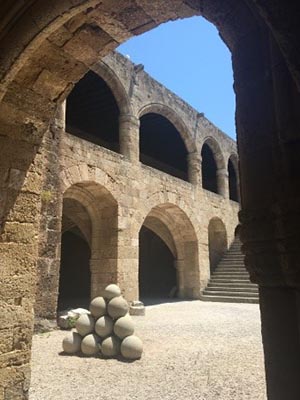 After we had dropped things off at the next hotel, we spent the day in the Old Town. My main aim was to get to the Archaeological Museum, the allure of the building almost being as strong as the artefacts housed inside it. It is located in the Hospital of the Knights of St John and although there wasn’t really a designated route through the main part of the museum, the building was so beautiful you really didn’t mind wandering around it slightly aimlessly. Once out of the main building, we could easily navigate the lovely gardens which connected lots of different exhibitions in various buildings. The epigraphy section was of particular interest for me, with the highlight being the inscription from 408/7BC concerning the Synoecism of the three main cities of Rhodes to form one main power house, Rhodes city. There were also large, impressive mosaics and lots of sacrificial offerings found in the wells inside the temples of Athena in the four main cities of Rhodes: Rhodes, Lindos, Kamiros and Ialyssos.
After we had dropped things off at the next hotel, we spent the day in the Old Town. My main aim was to get to the Archaeological Museum, the allure of the building almost being as strong as the artefacts housed inside it. It is located in the Hospital of the Knights of St John and although there wasn’t really a designated route through the main part of the museum, the building was so beautiful you really didn’t mind wandering around it slightly aimlessly. Once out of the main building, we could easily navigate the lovely gardens which connected lots of different exhibitions in various buildings. The epigraphy section was of particular interest for me, with the highlight being the inscription from 408/7BC concerning the Synoecism of the three main cities of Rhodes to form one main power house, Rhodes city. There were also large, impressive mosaics and lots of sacrificial offerings found in the wells inside the temples of Athena in the four main cities of Rhodes: Rhodes, Lindos, Kamiros and Ialyssos.
For an extra two euros, our ticket gave us access to three other museums in Rhodes – the Grand Master’s Palace, the Church of Our Lady of the Castle and a small museum with a collection of folklore items. They are also situated fairly closely to one another and we spent the afternoon exploring them.
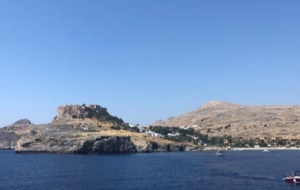 Day 14 (25 July)
Day 14 (25 July)
An early wake up was entirely worth making the boat trip we took down to Lindos, one of the most important centres in ancient Rhodes. The journey took two hours along the rugged coastline. A great bonus of arriving at Lindos via the sea was the stunning view of the acropolis you get as you sail in, as indeed the majority of people would have accessed the city by. It was truly breath-taking.
Despite getting there fairly early, the queue for the acropolis was very long. We were somewhat surprised having happily waltzed into every other site without even a whiff of queueing. Moreover, it was one of the most expensive sites we visited. With a view as beautiful as the one from the acropolis of Lindos, it is unsurprising that that was the highlight. The ruins themselves were slightly over-restored and not particularly extensive, however.
Theodore’s travel diary told of a pretty, little church he visited, but unfortunately we found it to be firmly locked up and closed to the public. Sophie read up some more online about the church and now I am very intrigued as to how Theodore got in, since they seemed very anti-tourist!
After grabbing lunch there, the boat took us via a couple of picturesque bays that were lovely to swim in. Once we were back in Rhodes, I headed for the Rhodian acropolis. There wasn’t too much there either – a heavily restored stadium and bouleuterion; the temple’s few standing columns covered in scaffolding; some underground caves thought to be Nymphaea; and lots of abandoned morning buildings dotted in between. I hadn’t noticed that I had been climbing much of a hill, but as I went past the caves and was heading back towards the hotel, I was greeted by a stunning view of sparkling blue sea extending into the distance further than I could see.
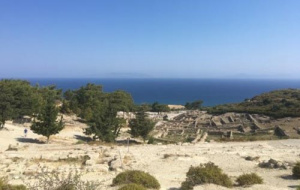 Day 15 (26 July)
Day 15 (26 July)
Travelling down the northern side of the island, we took a bus to Kamiros, another of Rhodes’ ancient cities. It has the most extensive ruins on the island, though in comparison to some of the Turkish sites it was still quite small. Once more, the views stole the show. Standing at the foundations of the temple of Athena on the city acropolis, you could see the extensive ruins of houses running down the hill leading to the agora at the foot at the hill and the sea running beyond that. The majority of what had been unearthed at Kamiros was housing, a reminder that these cities after all and that is what made up the majority of cities as they do now. It is easy to forget that at sites when you all see is one amazing monument after the other. The housing was from the Hellenistic period, which was an extra bonus for me. We had to wait a couple of hours for the bus back to the northern tip of the island and unfortunately, since our ferry was at 4.30pm and the email confirmation said we ought to arrive two hours beforehand, we did not have enough time to fit in Ialyssos.
Of course, check-in did not actually open until 3.45pm and the ferry didn’t leave on time, but that didn’t matter since it meant we could enjoy the Old Town a little more before we left. The wind had been kind to us when we were in Rhodes, keeping us as cool as possible, however, it also meant that half way through our journey, the boat had to cut the speed because it was so choppy. That meant we didn’t arrive into Fethiye until 7.30pm. Though feeling a little seasick, a sunset and view of the incredible Lycian rock tombs, carved into the mountainside.
The hotel was 5km away to the north of the port. That day just wasn’t our day, because, after we had been dropped off, we spent about 45 minutes looking for our hotel. Google Maps was trying to send us up a road that didn’t exist and all we got from a local shopkeeper I asked was a perplexed expression. As we continued searching amongst all the giant hotel signs, none of which were ours, a young girl on a bicycle became our knight in shining armour and pointed to an unmarked gate set back off the main street. So relieved to have found it, we called it a day.
Day 16 (27 July)
Tlos was one of the six main Lycian cities that formed the Lycian league in antiquity and was our target for the day. We took a dolmus headed towards Saklikent and after an hour or so, we were dropped off on another road side by a familiar brown sign pointing to road that wound up the mountains to our right. I knew Tlos was positioned high in the mountains and my suspicions were confirmed when Sophie checked on her phone how far it was to the site. It was 6km away and it was 11am, nearing the hottest point of the day. Though our travel guide had said that the dolmus should drop us by the site, this obviously was not the case. We were in a tiny, rural village and had no option but to start walking.
15 minutes into our walk, as the incline was starting to kick in, we were visited by another knight in shining armour, this time a local Turkish man who was driving by and offered to take us up. He spoke even less English than we did Turkish and refused any petrol money – it was just an act of pure and simple kindness. As the car kept climbing and climbing, we realised how fortunate we were.
This was another staggeringly beautiful site. As you come up the road, you see Lycian tombs carved into sheer rock face and not just at the bottom but dotted all around. They looked like miniature temples with their faux-columns and pediment decoration. The largest of them is fabled to be the tomb of Greek hero Bellerophon, who defeated the Chimera with his trusty companion, Pegasus. Within the tomb are wall paintings depicting this very scene, not that we were able to see it since it was so high up. I had not entirely clocked that the tomb was so high and pursued a slightly unbeaten track that went down the hill and wound round the sheer rock face. However, I would not recommend this to anyone else since it is very overgrown and comes out at quite a steep drop down rather than any tombs. Plus it’s quite a steep walk back up.
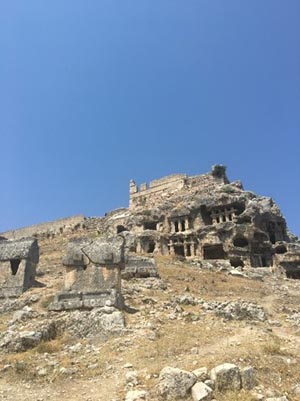 The site itself has enough rock tombs that you can get up close to and explore thoroughly. They are dotted all around the acropolis, which is crowned with the remains of the Ottoman Bloody Ali’s palace, famed for brutally killing whoever was travelling past without a suitable payment for him. His huge palace had removed any traces of whatever else had previously been there. Down from the acropolis, there is also a stadium, agora, fountain, baths, a small temple of Cronus and an impressive theatre. 8 years before, they had undertaken lots of digging in the theatre and had uncovered fully intact statues of a series of early Roman emperors, now housed in the Fethiye Museum.
The site itself has enough rock tombs that you can get up close to and explore thoroughly. They are dotted all around the acropolis, which is crowned with the remains of the Ottoman Bloody Ali’s palace, famed for brutally killing whoever was travelling past without a suitable payment for him. His huge palace had removed any traces of whatever else had previously been there. Down from the acropolis, there is also a stadium, agora, fountain, baths, a small temple of Cronus and an impressive theatre. 8 years before, they had undertaken lots of digging in the theatre and had uncovered fully intact statues of a series of early Roman emperors, now housed in the Fethiye Museum.
Fuelled by gozleme, we walked all the way back down the hill, not so lucky a life this time, but thankful that we were going down and not up. Once back in Fethiye, we went to Fethiye museum to see these statues. It is an excellent, small and free museum, very worth a visit. As well as the statues, I was drawn towards a stone with a trilingual decree on it, which allowed researchers to decipher the Lycian language – the Lycian Rosetta Stone. It also highlights how multicultural these communities were.
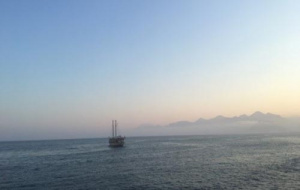 Day 17 (28 July)
Day 17 (28 July)
Most the day was spent travelling to Antalya, our final destination. It was the first of the many buses we had taken on our trip to break down and I was very glad it wasn’t our bus to Marmaris. Though we hadn’t broken down near any shade, the wait wasn’t insufferable since there were some other nice travellers on the bus. Like Izmir, Antalya’s otogar is some way out from the city centre but fortunately it was far easier to navigate than Izmir.
We dumped our stuff in the hotel and headed straight out again. It was now too late for museums, especially since the archaeology one was on the far other end of the town, so we wandered around the old town instead. We entered the old town via the impressive Hadrian’s gate and headed for the bazaar – we had been searching for Turkish football kits for all the family but it had been proving difficult to ones that were the right size, of Turkish football teams and not all the same design. Luckily for us, Antalya came up with the goods! Emerging from the bazaar, we came to the coastline and another stunning sunset. That evening, I had the best food of the whole trip at a restaurant called Hasanaga. There were lots of vegetarian mezze that we feasted on before my sister had the best lamb chops she had ever eaten. Our meal was accompanied by two brilliant saz players that we listened to for hours. Everyone else around us was polishing off bottles of raki but neither of us are fans our liquorice so decided to listen sober.
Day 18 (29 July)
On the last full day of our trip, I woke up early to go to the site I had been that I must visit the most of all, Termessos. A painless journey took me to the base of the Taurus mountains, and the only way to get nearer to the ancient Psidian city is a 10km road that climbs up 1km i.e. if you don’t have a car, you have to take a taxi and there are some there waiting to give lifts to tourists.
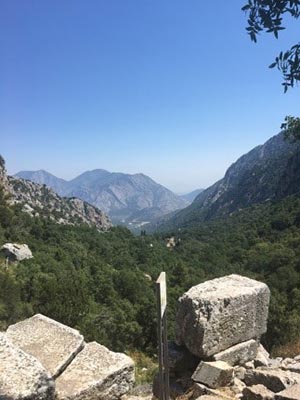 The city is so high up and difficult to access except via the main road, even Alexander the Great could not defeat the citizens of Termessos. Instead, he nicknamed it the eagle’s nest. My taxi driver dropped me off in the car park and then there was still another kilometre or so to walk, all uphill, which takes you past the city walls and into the city itself. Much of the sight hasn’t been thoroughly excavated / made suitable for swathes of tourists to visit, with paths quite vaguely marked and the rocks from collapsed buildings covering most of them. I think this is part of what made the site so special, and perhaps my favourite to visit. There are many things to visit here (if you are ready to scramble), but the theatre, placed on the edge of the mountain top and overlooking the Pamphilian plain, was the highlight. I sat there for some time – it was a truly extraordinary place.
The city is so high up and difficult to access except via the main road, even Alexander the Great could not defeat the citizens of Termessos. Instead, he nicknamed it the eagle’s nest. My taxi driver dropped me off in the car park and then there was still another kilometre or so to walk, all uphill, which takes you past the city walls and into the city itself. Much of the sight hasn’t been thoroughly excavated / made suitable for swathes of tourists to visit, with paths quite vaguely marked and the rocks from collapsed buildings covering most of them. I think this is part of what made the site so special, and perhaps my favourite to visit. There are many things to visit here (if you are ready to scramble), but the theatre, placed on the edge of the mountain top and overlooking the Pamphilian plain, was the highlight. I sat there for some time – it was a truly extraordinary place.
Returning back to Antalya, I made my way to the Archaeological Museum. It holds a great selection of statuary, predominantly from Perge, including a complete pantheon in very good condition. The Sarcophagus Hall was also very impressive. Walking back to the hotel, I went past the Ataturk Museum, which turned out to be a replica house of the one he used to stay in when he came to Antalya. There was next to no information inside except some old socks and pyjamas of his, but it was also free so I won’t complain!
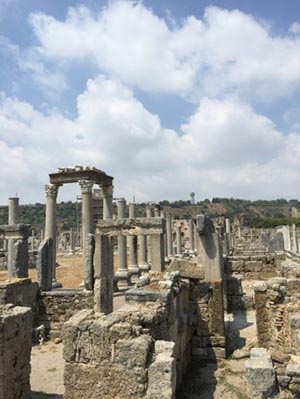 Day 19 (30 July)
Day 19 (30 July)
On our final day, we went to Perge, an originally Hellenistic city that was then heavily Romanised and from which period most of the remains date to. The site is massive and well worth exploring properly. It has long colonnaded streets stretching in all directions, with the majority of columns re-erected. Nymphaea, houses with mosaics and other surprises were dotted throughout the streets and it was fun placing all the things I had seen in the museum yesterday in the original positions. However, it was somewhat eerie how similar the streets felt to the ones we had walking around last night in Antalya. Just as cities like Antalya do now, Perge had a main strip and busy streets that were alive with business and bustle. Now, its columns and a small handful of tourists are all that remain.
There was also a vast stadium in very good condition there, which had a capacity of 12,000 people, rivalling the scale of the one at Aphrodisias. Across the road from the main site was the final theatre we would visit on our trip and it was a fitting way to finish our tour of ancient cities along the Aegean and Mediterranean coasts of Turkey.
All that was left to do was return to our hotel and head to the airport for our 23.55 flight, ready to sleep and tell everyone I see, willingly or unwillingly, about why they should visit Turkey too.
Find out more about the range of travel grants and scholarships available to assist Univ students on our Travel Grants page or read further travel reports.
Published: 7 November 2019
Explore Univ on social media
